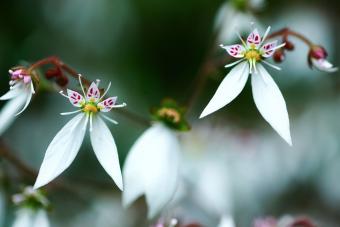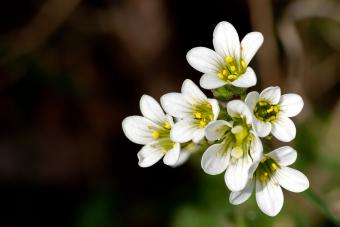
Saxifraga quite literally translates to "rock breaker," which should give you a good idea of the hardiness of these gorgeous plants. They're a symbol of perseverance and persistence in flower arrangements and bouquets, and, best of all, they're almost ridiculously easy to grow in even the toughest spots in your garden.
Saxifraga: Growing Rockfoil Flowers in Your Garden

Saxifraga are low-growing mounds or creeping plants that produce tiny flowers. They make excellent groundcovers and rock garden plants. Most varieties are woodland or alpine plants, and there's a good chance that you can find one that will work perfectly in your garden.
Rockfoil usually blooms spring through summer and grows best in moist but well-drained soil and in a spot that gets full to partial sun. For the most part, saxifraga is hardy in Zones 5 through 7. Many varieties are grown as annuals.
A Stunning Selection of Saxifraga
Aside from making for fun alliteration, saxifraga also offers plenty of delights for the gardener who's looking for something new and different. There are nearly 500 varieties of this very adaptable plant, which can be enough to make your head spin.
While there is a lot of diversity in this particular plant family, it's somewhat difficult to find saxifraga in most nurseries. Here are some of the most popular types available.
Strawberry Begonia (Saxifraga stolonifera)

These are perhaps the best-known of the saxifraga types. Strawberry begonias are popular houseplants, mostly because they're so attractive in addition to being low-maintenance. These plants form dense clumps of round, serrated leaves that are deep green with lighter veining, and reddish at the edges and undersides.
Strawberry begonias grow best in bright indirect sunlight (an east or west-facing window if grown as a houseplant), or in an area that gets some shade during the hottest part of the day if you're growing them in the landscape.
As far as watering, it's best to allow the soil to dry out before watering again. Like most saxifraga, strawberry begonias aren't overly fussy. They will grow better if fertilized with a balanced fertilizer every two weeks during the growing season. If you're growing it as a houseplant, cut back on the fertilizing during the fall and winter months.
Mossy Saxifraga (Saxifraga arendsii)

Mossy saxiragas are evergreen, so they provide a pop of color year-round, which is aways a nice addition to the landscape. They bloom in late spring through early summer, forming small pink, red, or white saucer-shaped flowers.
Mossy saxifraga grows best in moist soil and partial shade, either in the garden bed or in troughs or containers. These shade-loving rockfoils are hardy in Zones 5 through 8 and are generally carefree in terms of pest or disease issues. The only thing they won't tolerate well is a hot, dry, sunny site.
Meadow Saxifraga (Saxifraga granulata)

Meadow saxifraga is a great choice for brightening up shady rock gardens or woodland gardens. It naturalizes easily and is best planted in drifts, where its delicate, white, five-petaled flowers can have the most impact. This plant is happiest in full to partial shade.
Meadow saxifraga is hardy in Zones 4 through 9 and blooms in mid to late spring. This isn't a large plant, growing to only about 10 inches tall, though it will spread as long as it has room to do so. Because it's so well-behaved, it also works well in containers.
Purple Saxifraga (Saxifraga oppositifolia)

Purple saxifraga is a very low-growing, creeping groundcover that only gets about two inches tall. It produces tiny, light purple, pink, or red flowers in early spring and blooms throughout the spring and summer. The flowers are about half an inch across. It thrives in cool climates, so if you live in zones 6 or higher, this plant might not work well for you.
This saxifraga is hardy in Zones 2 through 7 and needs partial shade. It's very low maintenance and will withstand dry soil very well. It grows best in sandy or sandy loam; wet conditions will cause it to rot.
The flower petals of purple saxifraga are edible, and the stems and leaves can be used for tea.
Mountain Saxifraga (Saxifraga paniculata)

Mountain saxifraga grows well in moist, well-drained soil in areas that get partial shade, especially during the hottest part of the day. Alpine or mountain saxifraga forms a dense, spreading groundcover that grows to about six inches tall and blooms in tall, elongated clusters that grow up to 12 inches tall, blooming in shades of pink, white, yellow and purple in June through August.
Pyramidal Saxifraga (Saxifraga cotyledon)

Pyramidal saxifraga is another low-growing, creeping plant that works well in rock gardens, troughs, or planted in the crevices of rock walls. The foliage is a pretty grayish-green, and the small arching blooms are white. It grows best in part shade and moist, well-drained soil, and usually blooms in early summer.
What to Plant With Saxifraga
When figuring out which companion plants will work best with saxifraga, it makes sense to think about other rock garden plants, alpine plants, and succulents. All of these like the same soil conditions. A few options include:
- Sedum
- Sempervivum
- Echeveria
- Pasque flower
- Reticulated iris
- Euphorbia
- Purple coneflower
- Catmint
Saxifraga Pests and Problems
Rockfoils are generally pest and disease free. The only thing you might run into is that you may notice your saxifraga plants turning brown in the middle. This is completely normal, and part of the plant's natural growth habit.
As the plant grows and spreads, the middle will naturally start to grow weak and start dying. This is a sign that it's time to dig, divide, and transplant. Pull the dead, brown sections away before transplanting, and your saxifraga will look as good as new.
Tough and Beautiful
Saxifraga is one of those plants that not only survives, but absolutely thrives in conditions that would be difficult for many plants. Poor, sandy, moist soils, part shade, lack of fertility? Not a problem for these tough, beautiful plants. Whether you have an entire woodland garden or just a garden wall or container, rockfoil is definitely a plant worth adding to your garden.







